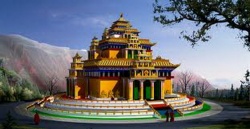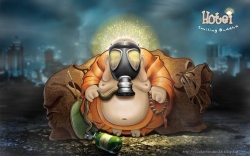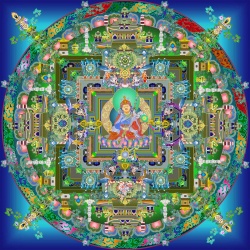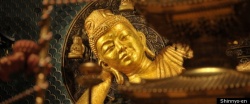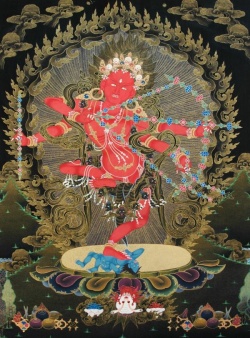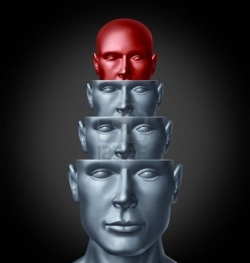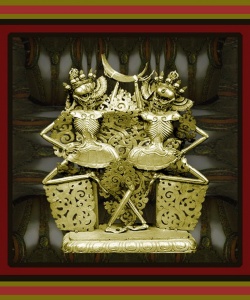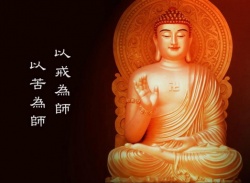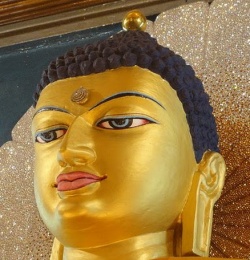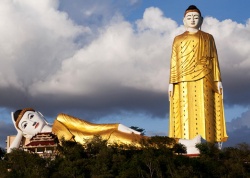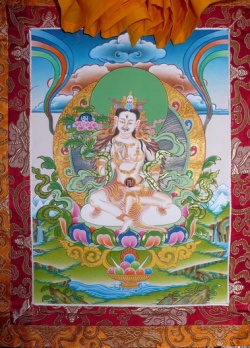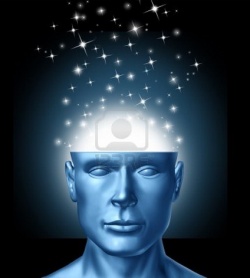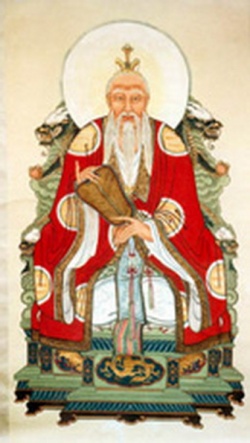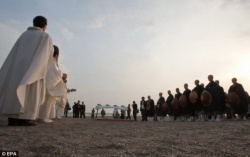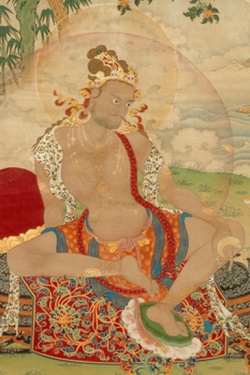The Aggressive Myth of Shambhala
The role of the ADI BUDDHA or rather of the Chakravartin is not just discussed in general terms in the Kalachakra Tantra, rather, in the “myth of Shambhala” the Time Tantra presents concrete political objectives. In this myth statements are made about the authority of the world monarch, the establishment and administration of his state, the organization of his army, and about a strategic schedule for the conquest of the planet. But let us first consider what exactly the Shambhala myth can be understood to be.
According to legend, the historical Buddha, Shakyamuni, taught the king of Shambhala, Suchandra, the Kalachakra Mulatantra, and initiated him into the secret doctrine. The original text contained 12,000 verses. It was later lost, but an abridged version survived. If we use the somewhat arbitrary calendar of the Time Tantra as a basis, the encounter between Shakyamuni and Suchandra took place in the year 878 B.C.E. The location of the instruction was Dhanyakataka close to the Mount Vulture Heap near Rajagriha (Rajgir) in southern India. After Suchandra had asked him for instruction, the Buddha himself assumed the form of Kalachakra and preached to him from a Lion Throne surrounded by numerous Bodhisattvas and gods.
Suchandra reigned as the king of Shambhala, a legendary kingdom somewhere to the north of India. He did not travel alone to be initiated in Dhanyakataka, but was accompanied by a courtly retinue of 96 generals, provincial kings and governors. After the initiation he took the tantra teaching back with him to his empire (Shambhala) and made it the state religion there; according to other reports, however, this only happened after seven generations.
Suchandra recorded the Kalachakra Mulatantra from memory and composed a number of comprehensive commentaries on it. One of his successors (Manjushrikirti) wrote an abridged edition, known as the Kalachakra Laghutantra, a compendium of the original sermon. This 1000-verse text has survived in toto and still today serves as a central text. Manjushrikirti’s successor, King Pundarika, composed a detailed commentary upon the Laghutantra with the name of Vimalaprabha (‘immaculate light’). These two texts (the Kalachakra Laghutantra and the Vimalaprapha) were brought back to India in the tenth century by the Maha Siddha Tilopa, and from there reached Tibet, the “Land of Snows” a hundred years later. But only fragments of the original text, the Kalachakra Mulatantra, have survived. The most significant fragment is called Sekkodesha and has been commented upon the Maha Siddha Naropa.
Geography of the kingdom of Shambhala
The kingdom of Shambhala, in which the Kalachakra teaching is practiced as the state religion, is surrounded by great secrecy, just as is its first ruler, Suchandra. Then he is also regarded as an incarnation of the Bodhisattva Vajrapani, the “Lord of Occult Knowledge”. For centuries the Tibetan lamas have deliberately mystified the wonderland, that is, they have left the question of its existence or nonexistence so open that one has to paradoxically say that it exists and it does not. Since it is a spiritual empire, its borders can only be crossed by those who have been initiated into the secret teachings of the Kalachakra Tantra. Invisible for ordinary mortal eyes, for centuries the wildest speculation about the geographic location Shambhala have circulated. In “concrete” terms, all that is known is that it can be found to the north of India, “beyond the River Sitha”. But no-one has yet found the name of this river on a map. Thus, over the course of centuries the numerous Shambhala seekers have nominated all the even conceivable regions, from Kashmir to the North Pole and everywhere in between.
The most widespread opinion in the studies tends toward seeking the original region in what is today the desert of the Tarim Basin (Tarim Pendi). Many lamas claim it still exists there, but is screened from curious eyes by a magical curtain and is well guarded. Indeed, the syncretist elements which are to be found in the Kalachakra Tantra speak for the view that the text is a product of the ancient Silk Road traversed by many cultures, which leads through the Tarim Basin. The huge chain of mountains which surround the plateau in almost a circle also concord with the geography of Shambhala.
Typically, the mythical map of Shambhala, of which there are numerous reproductions, resembles a mandala. It has the form of a wheel with eight spokes, or rather it corresponds to a lotus with eight petals. Each of the petals forms an administrative region. There a governor rules as the highest official. He is the viceroy of not less than 120 million villages which can be found on each “lotus petal”. Shambhala thus possesses a total of 960 million settlements. The whole land is surrounded by a ring of barely scaleable snowcapped mountains.
In the center of the ring of mountains lies the country’s capital, Kalapa by name. By night, the city of light is lit up as bright as day, so that the moon can no longer be seen. There the Shambhala king lives in a palace made from every conceivable gem and diamond. The architecture is based upon the laws of the heavens. There is a sun temple and a moon temple, a replica of the zodiac and the astral orbits. A little to the south of the palace the visitor finds a wonderful park. In it Suchandra ordered the temple of Kalachakra and Vishvamata to be built. It is made from five valuable materials: gold, silver, turquoise, coral, and pearl. Its ground plan corresponds to the Kalachakra sand mandala.
The kings and administration of Shambhala
All the kings of Shambhala belong to an inherited dynasty. Since the historical Buddha initiated the first regent, Suchandra, into the Time Tantra there have been two royal houses which have determined the fate of the country. The first seven kings called themselves Dharmaraja (kings of law). They were originally descended from the same lineage which produced Buddha Shakyamuni, the Shakyas. The following 25 kings of the second dynasty are the “Kulikas” or “Kalkis”. Each of these rulers reigns for exactly 100 years. The future regents are also already laid down by name. The texts are not always unanimous about who is presently ruling the realm. Most frequently, King Aniruddha is named, who is said to have taken the reins of power in 1927 and shall set them aside again in the year 2027. A great spectacle awaits the world when the 25th scion of the Kalki dynasty takes office. This is Rudra Chakrin, the wrathful wheel turner. In the year 2327 he will ascend the throne. We shall come to deal with him in detail.
Like the Indian Maha Siddhas, the Kalkis have long hair which they tie up in a knot. Likewise, they also adorn themselves with earrings and armbands. “The Kalki has excellent ministers, generals, and a great many queens. He has a bodyguard, elephants and elephant trainers, horses, chariots, and palanquins. His own wealth and the wealth of his subjects, the power of his magic spells, the nagas, demons, and goblins that serve him, the wealth offered to him by the centaurs and the quality of his food are all such that even the lord of the gods cannot compete with him. ... The Kalki does not have more than one or two heirs, but he has many daughters who are given as vajra ladies during the initiations held on the full moon of Caitra each year” (Newman, 1985, p. 57). It thus appears they serve as mudras in the Kalachakra rituals.
The ruler of Shambhala is a absolute monarch and has at his disposal the entire worldly and spiritual power of the country. He stands at the apex of a “hierarchical pyramid” and the foundations of his Buddhocracy is composed of an army of millions of viceroys, governors, and officers who carry out the decrees of the regent.
As spiritual ruler, he is the representative of the ADI BUDDHA, as “worldly” potentate a Chakravartin. He is seated upon a golden throne, supported by eight sculptured lions. In his hands he holds a jewel which grants him every wish and a magic mirror, in which he can observe and control everything in his realm and on earth. Nothing escapes his watchful eye. He has the ability and the right to look into the deepest recesses of the souls of his subjects, indeed of anybody.
The roles of the sexes in the realm of Shambhala are typical. It is exclusively men who exercise political power in the androcentric state. Of the women we hear only something of their role as queen mother, the bearer of the heir to the throne, and as “wisdom consorts”. In the “tantric economy” of the state budget they form a reservoir of vital resources, since they supply the “gynergy” which is transformed by the official sexual magic rites into political power. Alone the sovereign has a million (!) girls, “young as the eight-day moon”, who are available to be his partners.
The highest elite of the country is formed by the tantric clergy. The monks wear white, speak Sanskrit, and are all initiated into the mysteries of the Kalachakra Tantra. The majority of them are considered enlightened. Then come the warriors. The king is at the same time the supreme commander of a disciplined and extremely potent army with generals at its head, a powerful officer corps and obedient “lower ranks”. The most effective and “modern” weapons of destruction are stored in the extensive arsenals of Shambhala. Yet — as we shall later see — the army will only mobilize completely in three hundred years time (2327 C.E.).
The totalitarian power of the Shambhala king extends over not just the inhabitants of his country, but likewise over all the people of our planet, “earth”. The French Kalachakra enthusiast, Jean Rivière, describes the comprehensive competencies of the Buddhist despots as follows: “As master of the universe, emperor of the world, spiritual regent over the powerful subtle energy flows which regulate the cosmic order just as [they do] the lives of the people, the Kulika (king) of Shambhala directs the spiritual development of the human masses who were born into the heavy and blind material (universe)" (Rivière, 1985, p. 36). [1]
The “sun chariot” of the Rishis
Although all its rulers are known by name, the Shambhala realm has no history in the real sense. Hence in the many centuries of its existence hardly anything worthy of being recorded in a chronicle has happened. Consider in contrast the history-laden chain of events in the life of Buddha Shakyamuni and the numerous legends which he left behind him! But there is an event which shows that this country was not entirely free of historical conflict. This concerns the protest of a group of no less than 35 million (!) Rishis (seers) led by the sage Suryaratha ("sun chariot”).
As the first Kulika king, Manjushrikirti, preached the Kalachakra Tantra to his subjects, Suryaratha distanced himself from it, and his followers, the Rishis, joined him. They preferred to choose banishment from Shambhala than to follow the “diamond path” (Vajrayana). Nonetheless, after they had set out in the direction of India and had already crossed the border of the kingdom, Manjushrikirti sank in to a deep meditation, stunned the emigrants by magic and ordered demon birds to bring them back.
This event probably concerns a confrontation between two religious schools. The Rishis worshipped only the sun. For this reason they also called their guru the “sun chariot” (suryaratha). But the Kulika king had as Kalachakra master and cosmic androgyne united both heavenly orbs in himself. He was the master of sun and moon. His demand of the Rishis that they adopt the teachings of the Kalachakra Tantra was also enacted on a night of the full moon. Manjushrikirti ended his sermon with the words: “If you wish to enter that path, stay here, but if you do not, then leave und go elsewhere; otherwise the doctrines of the barbarians will com to spread even in Shambhala.” (Bernbaum, 1980, p. 234).
The Rishis decided upon the latter. “Since we all want to remain true to the sun chariot, we also do not wish to give up our religion and to join another”, they rejoined (Grünwedel, 1915, p. 77). This resulted in the exodus already outlined. But in fetching them back Manjushrikirti had proved his magical superiority and demonstrated that the “path of the sun and moon” is stronger than the “pure sun way”. The Rishis thus brought him many gold tributes and submitted to his power and the primacy of the Kalachakra Tantra. In the fifteenth night of the moon enlightenment was bestowed upon them.
Behind this unique historical Shambhala incident hides a barely noticed power-political motif. The seers (the Rishis) were as their name betrays clearly Brahmans; they were members of the elite priestly caste. In contrast, as priest-king Manjushrikirti integrated in his office the energies of both the priestly and the military elite. Within himself he united worldly and spiritual power, which — as we have already discussed above — are allotted separately to the sun (high priest) and the moon (warrior king) in the Indian cultural sphere. The union of both heavenly orbs in his person made him an absolute ruler.
Because of the Shambhala realm’s military plans for the future, which we will describe a little later, the king and his successors are extremely interested in strengthening the standing army. Then Shambhala will need an army of millions for the battles which are in store for it, and centuries count for nothing in this mythic realm. It was thus in Manjushrikirti’s interest to abolish all caste distinctions in an overarching militarily oriented Buddhocracy. The historical Buddha is already supposed to have prophesied that the future Shambhala king, “.. possessing the Vajra family, will become Kalki by making the four castes into an single clan, within the Vajra family, not making them into a Brahman family” (Newman, 1985, p. 64). The “Vajra family” mentioned is clearly contrasted to the priestly caste in this statement by Shakyamuni. Within the various Buddha families as well it represents the one who is responsible for military matters. Even today in the West, high-ranking Tibetan lamas boast that they will be reborn as generals (!) in the Shambhala army, that is, that they think to transform their spiritual office into a military one.
The warlike intention behind this ironing out of caste distinctions becomes more obvious in Manjushrikirti’s justification that the land, should it not follow Vajrayana Buddhism, would inevitably fall into the hands of the “barbarians”. These — as we shall later show — were the followers of Islam, against whom an enormous Shambhala military was being armed.
The journey to Shambhala
The travel reports written by Shambhala seekers are mostly kept so that we do not know whether they concern actual experiences, dreams, imaginings, phantasmagoria or initiatory progress. There is also no effort to keep these distinctions clear. A Shambhala journey simply embodies all of these together. Thus the difficult and hazardous adventures people have undertaken in search of the legendary country correspond to the “various mystical practices along the way, that lead to the realization of tantric meditation in the kingdom itself. ... The snow mountains surrounding Shambhala represent worldly virtues, while the King in the center symbolizes the pure mind at the end of the journey” (Bernbaum, 1980, p. 229).
In such interpretations, then, the journeys take place in the spirit. Then again, this is not the impression gained by leafing through the Shambha la’i lam yig, the famous travel report of the Third Panchen Lama (1738–1780). This concerns a fantastic collection , which is obviously convinced of the reality of its factual material, of historical and geographic particulars from central Asia which describe the way to Shambhala.
The landscapes which, according to this “classic travel guide”, a visitor must pass through before entering the wonderland, and the dangerous adventures which must be undergone, make the journey to Shambhala (whether real or imaginary) a tantric initiatory way. This becomes particularly clear in the central confrontation with the feminine which just like the Vajrayana controls the whole travel route. The quite picturesque book describes over many pages encounters with all the female figures whom we already know from the tantric milieu. With literary leisure the author paints the sweetest and the most terrible scenes: pig-headed goddesses; witches mounted upon boars; dakinis swinging skull bowls filled with blood, entrails, eyes and human hearts; girls as beautiful as lotus flowers with breasts that drip nectar; harpies; five hundred demonesses with copper-red lips; snake goddesses who like nixes try to pull one into the water; the one-eyed Ekajati; poison mixers; sirens; naked virgins with golden bodies; female cannibals; giantesses; sweet Asura girls with horse’s heads; the demoness of doubt; the devil of frenzy; healers who give refreshing herbs — they all await the brave soul who sets out to seek the wonderland.
Every encounter with these female creatures must be mastered. For every group the Panchen Lama has a deterrent, appeasing, or receptive ritual ready. Some of the women must be turned away without fail by the traveler, others should be honored and acknowledged, with yet others he must unite in tantric love. But woe betide him if he should lose his emotional and seminal control here! Then he would become the victim of all these “beasts” regardless of whether they appear beautiful or dreadful. Only a complete tantra expert can pursue his way through this jungle of feminine bodies.
Thus the spheres alternate between the external and the internal, reality and imagination, the world king in the hearts of individual people and the real world ruler in the Gobi Desert, Shambhala as everyday life and Shambhala as a fairytale dream, and everything becomes possible. When on his travels through Inner Asia the Russian painter, Nicholas Roerich, showed some nomads photographs of New York they cried out: “This is the land of Shambhala!” (Roerich, 1988, p. 274).
The “raging wheel turner”: The martial ideology of Shambhala
In the year 2327 (C.E.) — the prophecies of the Kalachakra Tantra tell us — the 25th Kalki will ascend the throne of Shambhala. He goes by the name of Rudra Chakrin, the “wrathful wheel turner” or the “Fury with the wheel”. The mission of this ruler is to destroy the “enemies of the Buddhist teaching” in a huge eschatological battle and to found a golden age. This militant hope for the future still today occupies the minds of many Tibetans and Mongolians and is beginning to spread across the whole world. We shall consider the fascination which the archetype of the “Shambhala warrior” exercises over western Buddhists in more detail later.
The Shambhala state draws a clear and definite distinction between friend and enemy. The original idea of Buddhist pacifism is completely foreign to it. Hence the Rudra Chakrin carries a martial symbolic object as his insignia of dominion, the “wheel of iron” (!).We may recall that in the Buddhist world view our entire universe (Chakravala) is enclosed within a ring of iron mountains. We have interpreted this image as a reminder of the “doomsday iron age” of the prophecies of antiquity.
Mounted upon his white horse, with a spear in his hand, the Rudra Chakrin shall lead his powerful army in the 24th century. “The Lord of the Gods”, it is said of him in the Kalachakra Tantra, “ joined with the twelve lords shall go to destroy the barbarians” (Newman, 1987, p. 645). His army shall consist of “exceptionally wild warriors” equipped with “sharp weapons”. A hundred thousand war elephants and millions of mountain horses, faster than the wind, shall serve his soldiers as mounts. Indian gods will then join the total of twelve divisions of the “wrathful wheel turner” and support their “friend” from Shambhala. This support for the warlike Shambhala king is probably due to his predecessor, Manjushrikirti, who succeeded in integrating the 120 million Hindu Rishis into the tantric religious system (Banerjee, 1985, p. xiii).
If, as legend has it, the author of the Kalachakra Tantra was the historical Buddha, Shakyamuni, in person, then he must have forgotten his whole vision and message of peace and had a truly great fascination for the military hardware. Then weaponry plays a prominent role in the Time Tantra. Here too, by “weapon” is understood every means of implementing the physical killing of humans. It is also said of Buddha’s martial successor, the coming Rudra Chakrin, that, “with the sella (a deadly weapon) in the hand ... he shall proclaim the Kalachakra on earth for the liberation of beings” (Banerjee, 1959, p. 213).
Lethal war machines
The graphic description of the war machines to which the Kalachakra deity devotes a number of pages already in the first chapter of the tantra is downright impressive and astonishing (Newman, 1987, pp. 553-570, verses 135-145; Grönbold, 1996). A total of seven exceptionally destructive arts of weapon are introduced. All take the form of a wheel. The text refers to them as yantras. There is a “wind machine” which is primarily put into action against mountain forts. They float over the enemy army and let burning oil run out all over them. The same happens to the houses and palaces of the opponent. The second art of weapon is described as a “sword in the ground machine”. This acts as a personal protection for the “wrathful wheel turner”. Anyone who enters his palace without permission and steps upon the machine hidden beneath the floor is inevitably cut to pieces. As the third art follows the “harpoon machine”, a kind of ancient machine gun. At the squeeze of a finger, “many straight arrows or sharp Harpoons hat pierce and pass through the body of an armored elephant” (Newman, 1987, p. 506).
We are acquainted with three further extremely effective “rotating weapons” which shear everything away, above all the heads of the enemy troops. One of them is compared to the wheels of the sun chariot. This is probably a variant of the solar discus which the Indian god Vishnu successfully put to use against the demon hordes. Such death wheels have played a significant role in Tibet’s magic military history right up into this century. We shall return to this topic at a later point. These days, believers in the Shambhala myth see “aircraft” or “UFOs” in them which are armed with atomic bombs and are guided by the world king’s extraterrestrial support troops.
In light of the numerous murderous instruments which are listed in the Kalachakra Tantra, a moral problem obviously arose for some “orthodox” Buddhists which led to the wheel weapons being understood purely symbolically. They concerned radical methods of destroying one’s own human ego. The great scholar and Kalachakra commentator, Khas Grub je, expressly opposes this pious attempt. In his opinion, the machines “are to be taken literally” (Newman, 1987, p. 561).
The “final battle”
Let us return to the Rudra Chakrin, the tantric apocalyptic redeemer. He appears in a period, in which the Buddhist teaching is largely eradicated. According to the prophecies, it is the epoch of the “not-Dharmas”, against whom he makes a stand. Before the final battle against the enemies of Buddhism can take place the state of the world has worsened dramatically. The planet is awash with natural disasters, famine, epidemics, and war. People become ever more materialistic and egoistic. True piety vanishes. Morals become depraved. Power and wealth are the sole idols. A parallel to the Hindu doctrine of the Kali yuga is obvious here.
In these bad times, a despotic “barbarian king” forces all nations other than Shambhala to follow his rule, so that at the end only two great forces remain: firstly the depraved “king of the barbarians” supported by the “lord of all demons “, and secondly Rudra Chakrin, the wrathful Buddhist messiah. At the outset, the barbarian ruler subjugates the whole world apart from the mythical kingdom of Shambhala. Its existence is an incredible goad to him and his subjects: “Their jealousy will surpass all limits, crashing up like waves of the sea. Incensed that there could be such a land outside their control, they will gather an army together und set out to conquer it.” (Bernbaum, 1980, p. 240). It then comes, says the prophecy, to a brutal confrontation. [2]
Alongside the descriptions from the Kalachakra Tantra there are numerous other literary depictions of this Buddhist apocalyptic battle to be found. They all fail to keep secret their pleasure at war and the triumph over the corpses of the enemy. Here is a passage from the Russian painter and Shambhala believer, Nicholas Roerich, who became well known in the thirties as the founder of a worldwide peace organization ("Banner of Peace”). “Hard is the fate of the enemies of Shambhala. A just wrath colors the purple blue clouds. The warriors of the Rigden-jyepo [the Tibetan name for the Rudra Chakrin], in splendid armor with swords and spears are pursuing their terrified enemies. Many of them are already prostrated and their firearms, big hats and all their possessions are scattered over the battlefield. Some of them are dying, destroyed by the just hand. Their leader is already smitten and lies spread under the steed of the great warrior, the blessed Rigden. Behind the Ruler, on chariots, follow fearful cannons, which no walls can withstand. Some of the enemy, kneeling, beg for mercy, or attempt to escape their fate on the backs of elephants. But the sword of justice overtake defamers. The Dark must be annihilated.” (Roerich, 1985, p. 232) The “Dark”, that is those of different faiths, the opponents of Buddhism and hence of Shambhala. They are all cut down without mercy during the “final battle”. In this enthused sweep of destruction the Buddhist warriors completely forget the Bodhisattva vow which preaches compassion with all beings.
The skirmishes of the battle of the last days (in the year 2327) are, according to commentaries upon the Kalachakra Tantra, supposed to reach through Iran into eastern Turkey (Bernbaum, 1982, p. 251). The regions of the Kalachakra Tantra’s origin are also often referred to as the site of the coming eschatological battlefield (the countries of Kazakhstan, Uzbekistan, Kyrgyzstan, Tajikistan, Turkmenistan and Afghanistan). This has a certain historical justification, since the southern “Islamic” flank of the former Soviet Union counts as one of the most explosive crisis regions of the present day (see in this regard the Spiegel, 20/1998, pp. 160-161).
The conquest of Kailash, the holy mountain, is nominated as a further strategic goal in the Shambhala battle. After the Rudra Chakrin has “killed [his enemies] in battle waged across the whole world, at the end of the age the world ruler will with his own fourfold army come into the city which was built by the gods on the mountain of Kailash” (Banerjee, 1959, p. 215). In general, “wherever the (Buddhist) religion has been destroyed and the Kali age is on the rise, there he will go” (Banerjee, 1959, p. 52). [3]
Buddha versus Allah
The armies of Rudra Chakrin will destroy the “not-Dharma” and the doctrines of the “unreligious barbarian hordes”. Hereby, according to the original text of the Kalachakra Tantra, it is above all the Koran which is intended. Mohammed himself is referred to by name several times in the Time Tantra, as is his one god, Allah. We learn of the barbarians that they are called Mleccha, which means the “inhabitants of Mecca” (Petri, 1966, p. 107). These days Rudra Chakrin is already celebrated as the “killer of the Mlecchas” (Banerjee, 1959, p. 52). This fixation of the highest tantra on Islam is only all too readily understandable, then the followers of Mohammed had in the course of history not just wrought terrible havoc among the Buddhist monasteries and communities of India — the Islamic doctrine must also have appeared more attractive and feeling to many of the ordinary populace than the complexities of a Buddhism represented by an elitist community of monks. There were many “traitors” in central Asia who gladly and readily reached for the Koran. Such conversions among the populace must have eaten more deeply into the hearts of the Buddhist monks than the direct consequences of war. Then the Kalachakra Tantra, composed in the time where the hordes of Muslims raged in the Punjab and along the Silk Road, is marked by an irreconcilable hate for the “subhumans” from Mecca.
This dualist division of the world between Buddhism on the one side and Islam on the other is a dogma which the Tibetan lamas seek to transfer to the future of the whole of human history. “According to certain conjectures”, writes a western commentator upon the Shambhala myth, “two superpowers will then have control over the world and take to the field against one another. The Tibetans foresee a Third World War here” (Henss, 1985, p. 19).
In the historical part of our analysis we shall come to speak of this dangerous antinomy once more. In contrast to Mohammed, the other “false doctrines” likewise mentioned in the first chapter of the Kalachakra Tantra as needing to be combated by the Shambhala king appear pale and insignificant. It nevertheless makes sense to introduce them, so as to demonstrate which founders of religions the tantric blanket conception of enemy stretched to encompass. The Kalachakra nominates Enoch, Abraham and Moses among the Jews, then Jesus for the Christians, and a “white clothed one”, who is generally accepted to be Mani, the founder the Manichaeism. It is most surprising that in a further passage the “ false doctrines “ of these religious founders are played down and even integrated into the tantra’s own system. After they have had to let a strong attack descend upon them as “heresies” in the first chapter, in the second they form the various facets of a crystal, and the yogi is instructed not to disparage them (Grönbold, 1992a, p. 295).
Such inconsistencies are — as we have already often experienced — added to tantric philosophy by itself. The second chapter of the Kalachakra Tantra thus does not switch over to a western seeming demand for freedom of religion and opinion, on the contrary apparent tolerance and thinking in terms of “the enemy” are both retained alongside one another and are, depending on the situation, rolled out to serve its own power interest. The Fourteenth Dalai Lama is — as we shall show in detail — an ingenious interpreter of this double play. Outwardly he espouses religious freedom and ecumenical peace. But in contrast, in the ritual system he concentrates upon the aggressive Time Tantra, in which the scenario is dominated by destructive fantasies, dreams of omnipotence, wishes for conquest, outbreaks of wrath, pyromaniacal obsessions, mercilessness, hate, killing frenzies, and apocalypses. That such despotic images also determine the “internal affairs” of the exiled Tibetans for the Tibetan “god-king”, is something upon which we shall report in the second part of our study.
After winning the final battle, the Kalachakra Tantra prophecies, the Rudra Chakrin founds the “golden age”. A purely Buddhist paradise is established on earth. Joy and wealth will abound. There is no more war. Everybody possesses great magical powers, Science and technology flourish. People live to be 1800 years old and have no need to fear death, since they will be reborn into an even more beautiful Eden. This blissful state prevails for around 20,000 years. The Kalachakra Tantra has by then spread to every corner of the globe and become the one “true” world religion. (But afterwards, the old cycle with its wars of destruction, defeats and victories begins anew.)
The non-Buddhist origins of the Shambhala myth
Apocalyptic visions, final battles between Good and Evil, saviors with lethal weapons in their hands are absolutely no topic for Hinayana Buddhism. They first emerge in the Mahayana period (200 B.C.E.), are then incorporated by Vajrayana (400 C.E.) and gain their final and central form in the Kalachakra Tantra (tenth century C.E.). Hence, as in the case of the ADI BUDDHA, the question arises as to where the non-Buddhist influences upon the Shambhala myth are to be sought.
Yet before we come to that, we ought to consider the widespread Maitreya prophecy, which collides with the Shambhala vision and the Kalachakra Tantra. Already in the Gandhara era (200 B.C.E.), Maitreya is known as the future Buddha who shall be incarnated on earth. He is still dwelling in the so-called Tushita heaven and awaits his mission. Images of him strike the observer at once because unlike other depictions of Buddha he is not resting in the lotus posture, but rather sits in a “European” style, as if on a chair. In his case too, the world first goes into decline before he appears to come to the aid of the suffering humanity. His epiphany is, however, according to most reports much more healing and peaceable than those of the “wrathful wheel turner”. But there are also other more aggressive prophecies from the seventh century where he first comes to earth as a messiah following an apocalyptic final battle (Sponberg, 1988, p. 31). For the Russian painter and Shambhala seeker, Nicholas Roerich, there is in the end no difference between Maitreya and Rudra Chakrin any more, they are simply two names for the same redeemer.
Without doubt the Kalachakra Tantra is primarily dominated by conceptions which can also be found in Hinduism. This is especially true of the yoga techniques, but likewise applies to the cosmology and the cyclical destruction and renewal of the universe. In Hindu prophecies too, the god Vishnu appears as savior at the end of the Kali yuga, also, incidentally, upon a white horse like the Buddhist Rudra Chakrin, in order to exterminate the enemies of the religion. He even bears the dynastic name of the Shambhala kings and is known as Kalki.
Among the academic researchers there is nonetheless the widespread opinion that the savior motif, be it Vishnu or Buddha Maitreya or even the Rudra Chakrin, is of Iranian origin. The stark distinction between the forces of the light and the dark, the apocalyptic scenario, the battle images, the idea of a militant world ruler, even the mandala model of the five meditation Buddhas were unknown among the original Buddhist communities. Buddhism, alone among all the salvational religions, saw no savior behind Gautama’s experience of enlightenment. But for Iran these motifs of salvation were (and still are today) central.
In a convincing study, the orientalist, Heinrich von Stietencron, has shown how — since the first century C.E. at the latest — Iranian sun priests infiltrated into India and merged their concepts with the local religions, especially Buddhism. (Stietencron, 1965. p. 170). They were known as Maga and Bhojaka. The Magas, from whom our word “magician” is derived, brought with them among other things the cult of Mithras and combined it with elements of Hindu sun worship. Waestern researchers presume that the name of Maitreya, the future Buddha, derives from Mithras.
The Bhojakas, who followed centuries later (600–700 C.E.), believed that they emanated from the body of their sun god. They also proclaimed themselves to be the descendants of Zarathustra. In India they created a mixed solar religion from the doctrines of the Avesta (the teachings of Zarathustra) and Mahayana Buddhism. From the Buddhists they adopted fasting and the prohibitions on cultivating fields and trade. In return, they influenced Buddhism primarily with their visions of light. Their “photisms” are said to have especially helped shape the shining figure of the Buddha Amitabha. Since they placed the time god, Zurvan, at the center of their cult, it could also be they who anticipated the essential doctrines of the Kalachakra Tantra.
Like the Kalachakra deity we have described, the Iranian Zurvan carries the entire universe in his mystic body: the sun, moon, and stars. The various divisions of time such as hours, days, and months dwell in him as personified beings. He is the ruler of eternal and of historical time. White light and the colors of the rainbow burst out of him. His worshippers pray to him as “father-mother”. Sometimes he is portrayed as having four heads like the Buddhist time god. He governs as the “father of fire” or as the “victory fire”. Through him, fire and time are equated. He is also cyclical time, in which the world is swallowed by flames so as to arise anew.
Manichaeism (from the third century on) also took on numerous elements from the Zurvan religion and mixed them with Christian/Gnostic ideas and added Buddhist concepts. The founder of the religion, Mani, undertook a successful missionary journey to India. Key orientalists assume that his teachings also had a reverse influence upon Buddhism. Among other aspects, they mention the fivefold group of meditation Buddhas, the dualisms of good and evil, light and darkness, the holy man’s body as the world in microcosm, and the concept of salvation. More specific are the white robes which the monks in the kingdom of Shambhala wear. White was the cult color of the Manichaean priestly caste and is not a normal color for clothing in Buddhism. But the blatant eroticism which the Kalachakra translator and researcher in Asia, Albert Grünwedel, saw in Manichaeism was not there. In contrast; Mani’s religion exhibits extremely “puritanical” traits and rejects everything sexual: “The sin of sex”, he is reported to have said, “is animal, an imitation of the devil mating. Above all it produces every propagation and continuation of the original evil” (quoted by Hermanns, 1965, p. 105).
While the famous Italian Tibetologist, Guiseppe Tucci, believes Iranian influences can be detected in the doctrine of ADI BUDDHA, he sees the Lamaist-Tibetan way in total rather as gnostic, since it attempts to overcome the dualism of good and evil and does not peddle the out and out moralizing of the Avesta or the Manichaeans. This is certainly true for the yoga way in the Kalachakra Tantra, yet it is not so for the eschatology of the Shambhala myth. There, the “prince of light” (Rudra Chakrin) and the depraved “prince of darkness” take to the field against one another.
There was a direct Iranian influence upon the Bon cult, the state religion which preceded Buddhism in Tibet. Bon, often erroneously confused with the old shamanist cultures of the highlands, is a explicit religion of light with an organized priesthood, a savior (Shen rab) and a realm of paradise (Olmolungring) which resembles the kingdom of Shambhala in an astonishing manner.
It is a Tradition in Europe to hypothesize ancient Egyptian influences upon the tantric culture of Tibet. This can probably be traced to the occult writings of the Jesuit, Athanasius Kirchner (1602-1680), who believed he had discovered the cradle of all advanced civilizations including that of the Tibetans in the Land of the Nile. The Briton, Captain S. Turner, who visited the highlands in the year 1783, was likewise convinced of a continuity between ancient Egypt and Tibet. Even this century, Siegbert Hummel saw the “Land of Snows” as almost a “reserve for Mediterranean traditions” and likewise nominated Egypt as the origin of the tradition of the Tibetan mysteries (Hummel, 1954, p. 129; 1962, p. 31). But it was especially the occultist Helena Blavatsky who saw the origins of both cultures as flowing from the same source. The two “supernatural secret societies”, who whispered the ideas to her were the “Brotherhood of Luxor” and the “Tibetan Brotherhood”.
The determining Greek influence upon the sacred art of Buddhism (Gandhara style) became a global event which left its traces as far afield as Japan. Likewise, the effect of Hellenistic ideas upon the development of Buddhist doctrines is well vouched for. There is widespread unanimity that without this encounter Mahayana would have never even been possible. According to the studies of the ethnologist Mario Bussagli, hermetic and alchemic teachings are also supposed to have come into contact with the world view of Buddha via Hellenistic Baktria (modern Afghanistan) and the Kusha empire which followed it, the rulers of which were of Scythian origin but had adopted Greek language and culture (Bussagli, 1985).
Evaluation of the Shambhala myth
The ancient origins and contents of the Shambhala state make it, when seen from the point of view of a western political scientist, an antidemocratic, totalitarian, doctrinaire and patriarchal model. It concerns a repressive ideal construction which is to be imposed upon all of humanity in the wake of an “ultimate war”. Here the sovereign (the Shambhala king) and in no sense the people decide the legal norms. He governs as the absolute monarch of a planetary Buddhocracy. King and state even form a mystic unity, in a literal, not a figurative sense, then the inner bodily energy processes of the ruler are identical with external state happenings. The various administrative levels of Shambhala (viceroys, governors, and officials) are thus considered to be the extended limbs of the sovereign.
Further to this, the Shambhala state (in contrast to the original teachings of the Buddha) is based upon the clear differentiation of friend and enemy. Its political thought is profoundly dualist, up to and including the moral sphere. Islam is regarded as the arch-enemy of the country. In resolving aggravated conflicts, Shambhala society has recourse to a “high-tech” and extremely violent military machinery and employs the sociopolitical utopia of “paradise on earth” as its central item of propaganda.
It follows from all these features that the current, Fourteenth Dalai Lama’s constant professions of faith in the fundamentals of western democracy remain empty phrases for as long as he continues to place the Kalachakra Tantra and the Shambhala myth at the center of his ritual existence. The objection commonly produced by lamas and western Buddhists, that Shambhala concerns a metaphysical and not a worldly institution, does not hold water. We know, namely, from history that both traditional Tibetan and Mongolian society cultivated the Shambhala myth without at any stage drawing a distinction between a worldly and a metaphysical aspect in this matter. In both countries, everything which the Buddhocratic head of state decided was holy per se.
The argument that the Shambhala vision was distant “pie in the sky” is also not convincing. The aggressive warrior myth and the idea of a world controlling ADI BUDDHA has influenced the history of Tibet and Mongolia for centuries as a rigid political program which is oriented to the decisions of the clerical power elite. In the second part of our study we present this program and its historical execution to the reader. We shall return to the topic that in the view of some lamas the Tibetan state represents an earthly copy of the Shambhala realm and the Dalai Lama an emanation of the Shambhala king.
“Inner” and “outer” Shambhala
In answer to the question as to why the “world ruler on the Lion Throne” (the Shambhala king) does not peacefully and positively intervene in the fate of humanity, the French Kalachakra believer, Jean Rivière, replied: “He does not inspire world politics and does not intervene directly or humanly in the conflicts of the reborn beings. His role is spiritual, completely inner, individual one could say” (Rivière, 1985, p. 36).
Such an “internalization” or “psychologization” of the myth is applied by some authors to the entire Buddhocratic realm, including the history of Shambhala and the final battle prophesied there. The country, with all its viceroys, ministers, generals, officials, warriors, ladies of the court, vajra girls, palace grounds, administrative bodies and dogmata, now appears as a structural model which describes the mystic body of a yogi: “If you can use your body properly, than the body becomes Shambhala, the ninety-six principalities concur in all their actions, and you conquer the kingdom itself.” (Bernbaum, 1980, p. 155)
The arduous “journey to Shambhala” and the “final battle” are also subjectified and identified as, respectively, an “initiatory path” or an “inner battle of the soul” along the way to enlightenment. In this psycho-mystic drama, the ruler of the last days, Rudra Chakrin, plays the “higher self” or the “divine consciousness” of the yogi, which declares war on the human ego in the figure of the “barbarian king” and exterminates it. The prophesied paradise refers to the enlightenment of the initiand.
We have already a number of times gone into the above all among western Buddhists widespread habit of exclusively internalizing or “psychologizing” tantric images and myths. From an “occidental” way of looking at things, an internalization implies that an external image (a war for example) is to be understood as a symbol for an inner psychic/spiritual process (for example, a “psychological” war). However, according to Eastern, magic-oriented thinking, the “identity” of interior and exterior means something different, namely that the inner processes in the yogi’s mystic body correspond to external events, or to tone this down a little , that inside and outside consist of the same substance (of “pure spirit” for example). The external is thus not a metaphor for the internal as in the western symbolic conception, but rather both, inner and exterior, correspond to one another. Admittedly this implies that the external can be influenced by inner manipulations, but not that it thereby disappears. Applying this concept to the example mentioned above results in the following simple statement: the Shambhala war takes place internally and externally. Just as the mystic body (interior) of the ADI BUDDHA is identical with the whole cosmos (exterior), so the mystic body (interior) of the Shambhala king is identical to his state (exterior).
The Shambhala myth and the ideologies derived from it stand in stark opposition to Gautama Buddha’s original vision of peace and to the Ahimsa politics (politics of nonviolence) of Mahatma Ghandi, to whom the current Dalai Lama so often refers. For Westerners sensitized by the pacifist message of Buddhism, the “internalization” of the myth may thus offer an way around the militant ambient of the Kalachakra Tantra. But in Tibetan/Mongolian history the prophecy of Shambhala has been taken literally for centuries, and — as we still have to demonstrate — has led to extremely aggressive political undertakings. It carries within it — and this is something to we shall return to discuss in detail — the seeds of a worldwide fundamentalist ideology of war.
Footnotes:
[1] In the thirties, Jean Marquès Rivière worked on the journal Voile d'Isis, in which the occult elite of Europe published. The editor was René Guénon. During this period Rivière performed a tantric ritual ("with blood and alcohol”), which left him possessed by a Tibetan deity. Only through the intervention of a Catholic exorcist could he be freed of the possession. In gratitude he reconverted to Christianity. But several years later he was once again to be found in the Buddhist camp (Robin, 1986, p. 325).
[2] In another version of the prophecy the barbarians at first succeed in penetrating into the wonderland and storming the palace of the king. Rudra Chakrin then extends the offer of ruling Shambhala together with his opponents. The barbarian king apparently consents, but then tries to seize control alone with an attempted assassination. But the attempt fails, and the Shambhala king escapes. Only now does the bloody final battle of Good versus Evil occur.
[3] The scenario of the Shambhala wars cannot be easily brought into accord with the total downfall of the world instigated by the tantra master which we have described above. Rudra Chakrin is a commander who conducts his battles here on earth and extends these to at best the other 11 continents of the Buddhist model of the world. His opponents are above all the followers of Allah. As global as his mission may be, it is still realized within the framework of the existing cosmos. In other textual passages the coming Shambhala king is also compared with the ADI BUDDHA, who at the close of the Kali yuga lays waste to the entire universe and lets loose a war of the stars. It is, however, not the aim of this study to explicate such contradictions.



